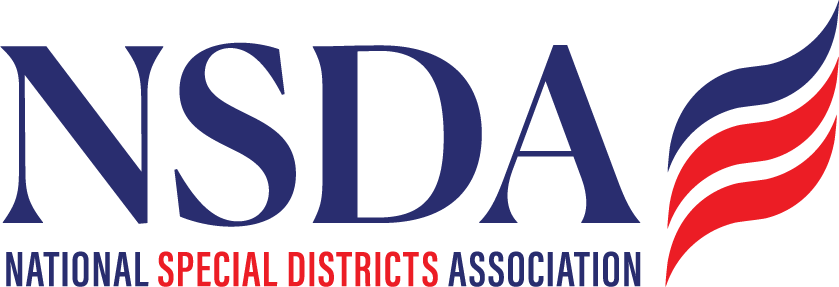Climate Adaptation & Community Resiliency
Special districts provide services susceptible to the effects of adverse impacts of climate change. Special districts, like many other local government entities, are taking steps to build resilient infrastructure to withstand extreme conditions. NSDC’s priority is to enhance special districts’ position as local government stakeholders in climate policy discussion. In general, this section looks at special districts’ priorities covering adaptation, resiliency, and emergency preparedness.
NSDC’s mission is to support policies and develop partnerships with stakeholders to achieve common goals for all disaster-impacted and disaster-prone special districts.
Many special districts provide essential services in communities prone to wild fires, operating in the urban-wild land interface and in rural areas. Catastrophic, year-round wildfire risk is an increasing phenomenon resulting from climate change, forest management issues, and failures in utility infrastructure. Many special districts operate in urban-wildland interface regions facing direct wildfire threats to critical infrastructure. Further, water and irrigation districts sourcing water from fire-impacted watersheds are impacted due to contaminants and soil erosion these events create.
With direct and indirect impacts on services, NSDC is focused on furthering policies providing U.S. Department of Agriculture, Department of Interior, and other federal agencies with tools for appropriate forest management, forest restoration, and post-fire/water quality mitigation efforts.
Drought impacts districts providing irrigated water for agricultural use, drinking water, natural resource conservation, wastewater, fire protection, and more. NSDC seeks to support districts’ drought-related adaptation and resilient infrastructure needs, including programs assisting special districts’ preparation for and response to extreme drought.
NSDC recognizes that certain types of special districts are more reliant than others on water resources to ensure delivery of quality services. Irrigation districts, primarily in the Western U.S., depend on water allocations to provide drinking water for communities and to grow the food and fiber America and the world depend on. Some irrigation districts produce electricity, offering a supplemental source for the power grid. Furthermore, some port and navigation districts are located on rivers to move commerce and drive local economies.
As the federal government is ingrained in much of the nation’s water resources through the U.S. Army Corps of Engineers and Bureau of Reclamation, NSDC broadly advocates for sound policies and investments in solutions facing drought-stricken, major river basins and watersheds. In all, NSDC supports and encourages programs that enhance water infrastructure, conservation, groundwater recharge, recycling, and storage.
The special districts services communities rely upon often become even more essential during extreme weather events and disasters. Special district facilities not only provide critical infrastructure – such as emergency response and rescue, healthcare and hospital, drinking water, wastewater treatment, storm water capture, flood control services, and more – but are also serve as central hubs for resources and refuge. Special districts’ community facilities are prime locations for community cooling stations, emergency shelters, safe rooms, and more.
As such, NSDC supports efforts to harden infrastructure and mitigate the impacts of extreme weather events. Programs designed to ensure local governments, including special districts, can adequately prepare for and efficiently respond to crises are critical. The Coalition supports development and implementation of programs meeting this need, and, accordingly, advocates for eligibility in the same fashion as other units of local government.
NSDC seeks to cultivate partnerships and communication with key federal agencies administering these programs, such as the Federal Emergency Management Agency and the Cybersecurity and Infrastructure Security Agency, to ensure districts are considered for relevant programming.
The nation’s special districts are no exception to the rising threat of hacks and ransomware attacks on critical infrastructure. Many special districts operate critical infrastructure on connected systems vulnerable in similar fashions as city, county, and state counterparts. Special districts deliver public services to millions of Americans and utilize online software to conduct financial transactions. NSDC supports policies bolstering programs to enhance readiness, threat assessment, and response capabilities for public agencies. The coalition works to enhance special districts’ awareness of programs addressing cybersecurity policies and to connect special districts with federal resources addressing cyber threats.
NSDC promotes measures special districts are taking to ensure continuity of services, respond to community needs, and take proactive measures before a crisis unfolds. Likewise, the Coalition supports programs to enhance public programs providing resources for agencies to adequately prepare for emergency. This includes, but is not limited to, ensuring special districts are considered in Federal Emergency Management Agency (FEMA)’s intergovernmental collaboration efforts as well as collaboration efforts from other federal agencies administering readiness and residency programs for public agencies. Furthermore, NSDC advocates for federal decisionmakers to consider special districts in guidance for critical public programs including FEMA’s risk management and resiliency programs, as well as to be stakeholders in development of future public emergency preparedness programs.
Historic authorizations were made law in the early 2020s for the nation’s drinking water and wastewater treatment infrastructure in response to the COVID-19 pandemic and with the Infrastructure Investments and Jobs Act. While these measures have enhanced the nation’s health, safety, and quality of life, there remains a gap in assistance for local infrastructure development to achieve adequate resources for fire suppression.
While all types of local government are responsible for fire protection and water services, special districts are vested in this policy issue, as more than 6,000 special districts provide fire protection services and more than 4,500 provide water services to millions of Americans every day. NSDC produced a 2022 report addressing this policy issue and proposed sets of legislative and stakeholder recommendations to close these gaps.
NSDC seeks to collaborate with a broad range of partners in advocacy to pilot a stand-alone, cost share grant program to directly aid all types of local government to address infrastructure gaps for fire suppression needs. As a function of mitigation, NSDC recommends the program to be housed within FEMA. Ideally, this program would (1) be flexible with consideration of regional geographic factors driving a heightened need for fire suppression infrastructure investments, (2) be locally driven based on collaborative solutions, and (3) provide opportunities for technical assistance and cost share.
